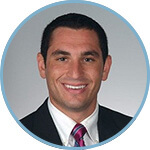 Mathew Wooster, MD, is in his fifth and final year of the integrated residency program at the University of South Florida in Tampa. Dr. Wooster shares his experience with FEVAR as a fellow and how it has impacted his job search.
Mathew Wooster, MD, is in his fifth and final year of the integrated residency program at the University of South Florida in Tampa. Dr. Wooster shares his experience with FEVAR as a fellow and how it has impacted his job search.
How did you get involved with fenestrated cases as a fellow?
Getting involved initially as a fellow is pretty straightforward. Basically, your attendings book a case and you figure out you have to learn how to do it. I already had a basic understanding of the procedure from going to a bunch of different meetings, so I was very curious about it and talked to my faculty about it. And when we got it here, I just jumped at the first case they were doing to try to start being involved—double scrubbing because at that time I was a junior resident. And then as I got more senior, planning the cases and doing the cases independently with the attendings.
What would you tell other fellows to help them get more exposure and experience with FEVAR techniques?
I don’t know that there’s anything anybody can do to get more exposure other than having the cases be available to them. It’s really a matter of knowing that the technology is there and whenever you see a patient with an aneurysm, you have to assess them and decide, is this patient a candidate? And if they are, advocate for it. It’s the only on-label technology we have right now for juxtarenal aneurysms and it certainly has the best data behind it. Obviously, there’s a lot of proponents for snorkels and we do our fair share here, but this is the only thing that’s actually on label to treat this pathology. Tell your faculty that you’d like to try it and that the data supports doing it over an open aneurysm repair with the appropriate patient selection. Getting after it that way is the only way to do it, really.
As you get ready to go into practice, how has learning these skills impacted your decision on where to go?
It’s helped in the sense that I have a pre-formed understanding of what I want to do. I want to have a fair amount of aortic work in my practice and so I was looking for a facility where that would be supported and encouraged as well as a facility that was going to both support and encourage fenestrated repairs.
And in terms of finding the right fit, I found that. I’m going to be going into university practice. They have a fairly large aortic experience right now. They have one of the larger fenestrated experiences in the country. The person who was doing most of those happened to be leaving, so I’ll slide right in as another person to help fill that role.
Did FEVAR make you more marketable coming out of fellowship?
Definitely. It was definitely very much sought after to know that you had somebody coming in who could offer really any level of endovascular or open experience. Being able to have the full array of treatments is crucial. There’s a lot of practices that have predominately older surgeons still, and they’re looking to bring in somebody younger who can offer this to patients. There’s other practices that have some younger people who are doing it, and they just want help. The reality is that a fenestrated case is at least a two-physician case. You need two sets of hands in addition to a tech. There are some practices where they just need a second person who knows what they’re doing with this stuff to be able to technically accomplish it. So knowing that I had that ability definitely made me more marketable to people.
Get stories like these sent to your email.
Sign up for our quarterly email newsletter to receive physician stories, product news, training opportunities and more in your inbox.
Mathew Wooster, MD, is an independent physician with no financial ties to Cook Medical.